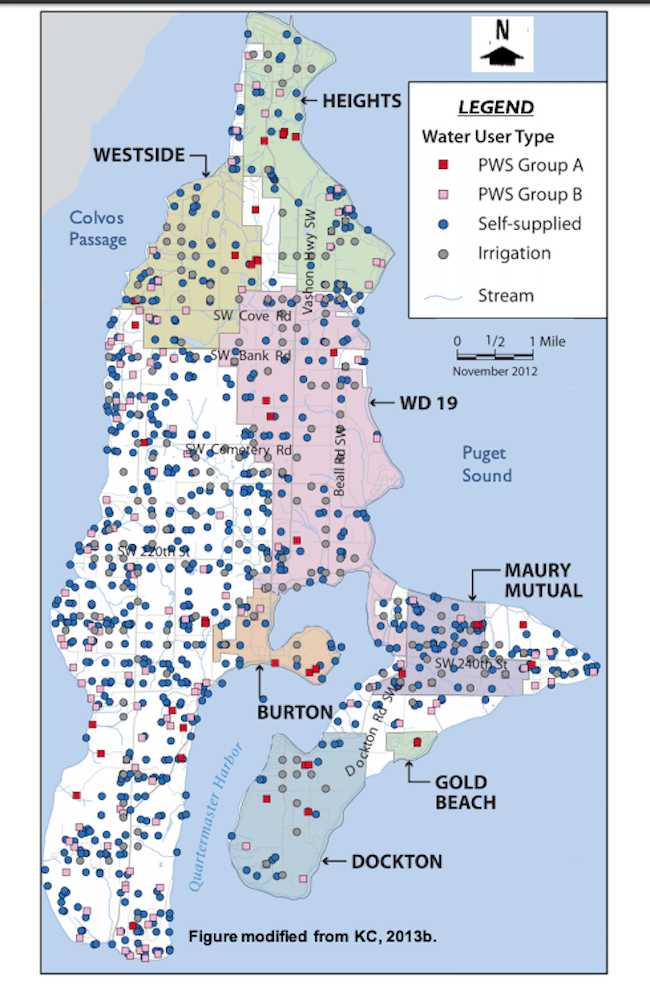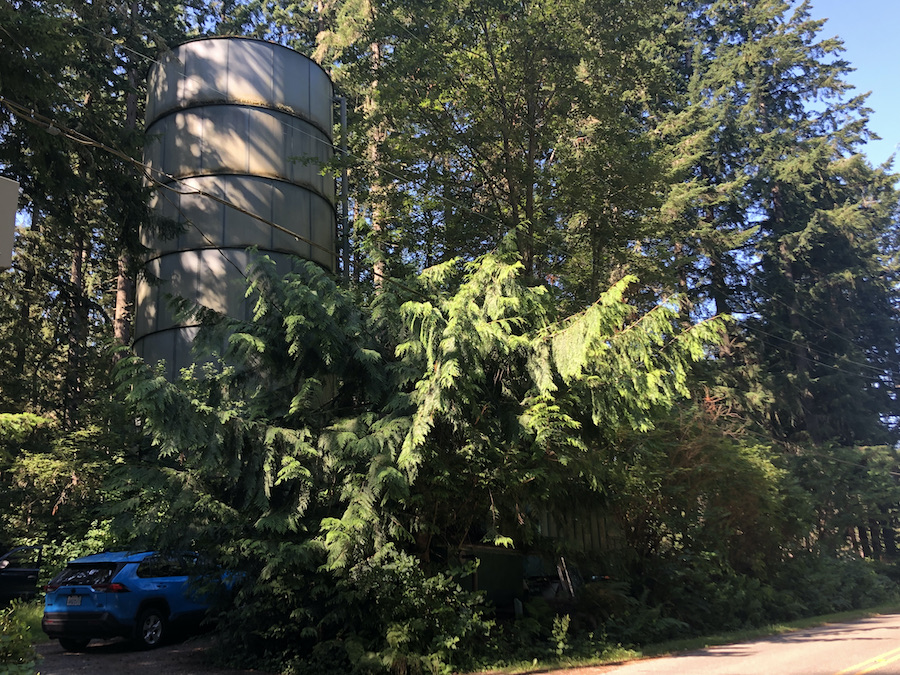This is the ninth in a monthly series of guest blog posts about island groundwater by Mary Bruno, Vashon-Maury Island Groundwater protection committee. As part of this series Mary interviews local water purveyors on the island.
In February of this year, the Westside Water Association submitted a revised Small Water System Management Plan to the Washington State Department of Health. The member-owned WWA is one of Vashon-Maury Island’s seven large Group A water systems (see map). Its new planning document is a good read, laying out Westside’s 93-year history and its strategy for the future in concise, well-crafted prose. The highlight (on page 54) was Westside’s request for 24 additional water shares. When DOH granted that request last week, it set the stage for Westside Water’s first offer of new water shares since 1988.
The Association’s five-member board will brief its membership in an August 5 Zoom meeting. On August 19, Westside members will vote, in-person, on the proposed by-law revisions that will govern how new shares are awarded. As a WWA member, I worry about the boost in shares inviting ill-advised development and overtaxing the water supply. So I did what I always do when I worry about water: I called Doug Dolstad.
Doug is a Vashon homey whose community-minded parents were very active in the Westside Water Association. “I basically grew up helping out with the system,” says Doug, whose company (Island Water Management, Inc.) has been managing WWA since 1992. The Association was incorporated on June 12, 1928, by eight West-side neighbors who “associated . . . together for the purpose of forming a nonprofit corporation . . . for the benefit of ourselves and others in order to obtain a community water system . . . ” The inaugural system—a small dam on Shinglemill Creek, a water tower and some pipelines—delivered potable water to about 20 farms. Today, WWA serves 235 connections. The capacity analysis that the WWA board conducted for its Small Water System Management Plan projected the potential to serve 24 more.

I chatted with Doug, by phone and email, about the new water shares, about Westside’s persistent search for dependable water sources, and about the soft power of local water districts. This is the first of our two-part conversation. (My questions appear in bold.)
Let’s start with a little background. Westside has had supply side setbacks over the years. In 1988, it lost the Shinglemill Creek dam to a flood. In 2002, it lost full use of the creek-adjacent Canyon Well to high arsenic levels. In 2012, DOH took one of its source springs off-line. Over the years several well points in the Canyon stopped producing. It must be tough keeping up with demand.
“Yes, it has been a challenge at times. The highest producing spring was determined by DOH to be ‘groundwater under the influence of surface water.’ [Translation: Using that spring’s water risked introducing bio-contaminants such as bacteria or parasites into Westside’s supply.] That was a loss. The Canyon Well was drilled in 2002. It produced 65 gallons per minute. Whee! It also had 32 parts per billion (ppb) arsenic. Booo! We installed a filter; didn’t work as planned.
“Westside Water is 97 percent residential. Average consumption during the low-use period [October through May] is around 150 gallons per day per household. In the high-use season [June through September] that doubles—and can triple at the extremes. That usage pattern hasn’t changed all that much. But since the dam washed away back in 1988 Westside has been under-sourced. It’s been a constant struggle—and stress for me as the operator—trying to find enough safe and reliable water.”
When the Canyon Well came on line in 2002, Washington State’s upper limit for arsenic in drinking water was 50 ppb. In 2004, the State dropped its safe arsenic level to 10 ppb. How did that effect usage of the Canyon Well?
“That well is only used now to the extent that blending its water with our other source water will reduce the arsenic levels to 5 ppb, with a max of 10 ppb in extreme situations.” [This summer’s heat wave had “extreme situation” written all over it. Westside warned members that it might have to tap the Canyon Well to meet demand. In the end, that wasn’t necessary.]
One of your supply side solutions has been to purchase private wells.
“Westside has been the most active [purveyor] I know of in that particular strategy. We acquired the Anderson Well in 2015, along with the option to drill a new well on that site which we did in 2016. We acquired the Back 40 Well in 2020.” [It should come on line this summer.]
WWA’s new Small Water System Management Plan replaces a previous “Comprehensive Plan” that was 15 years old. Did the new wells trigger the new plan?
“Short answer: Yes. Two big laws govern water utilities: the Coordinated Water System Supply Plan and the Municipal Water Law. The Coordinated Water System Supply Plan is basically saying, ‘Look, we can’t coordinate things if people don’t have plans.’ You’re supposed to have a Comprehensive Plan. You’re supposed to renew it every six years if you’re an “expanding” system. But a lot of [oversight] depends on the bureaucrat in charge. In the case of the Anderson Well, [DOH] just said, ‘Good for you.’ With the Back 40 Well, DOH rightfully said, ‘Congratulations on your new source, but guess what? We’re not going to approve it until we have your updated planning document.’”
So the new wells, especially the Back 40, solved WWA’s “under-sourced” problem and generated a new strategic plan. But why 24 new water shares? Isn’t that a little optimistic given WWA’s shaky supply history?
“It’s not that Westside—philosophically, as a board—said, ‘We want to serve all these parcels.’ Over the years there’s been considerable reluctance to do that actually. Some of that reluctance is driven by some Association members wanting a certain rural quality of life and using the [Westside Water] utility bylaws to control growth. Some of the reluctance is practical: we’ve been relying on sources that are probably not as reliable as we are comfortable with in the long-term. That said, the capacity of the Back 40 Well is 30 gallons a minute, though we tend to use it at 75 percent capacity. [Thirty gallons per minute equals 15,768,000 gallons per year—from that one source. Westside currently delivers a total of 15 million gallons annually.]
“Thirty gallons a minute is more than Westside needs. So what do you do with the excess? Enter the [Municipal Water Law’s 2017] Duty to Serve clause: If you can serve more parcels you have to. Well, how many more can you serve?”
Calculations for WWA’s new Small Water System Management Plan provided the answer: 24. DOH has given its blessing. Westside’s membership weighs in on August 19. In Part 2 of my conversation with Doug, we talk about the math and how new shares will be awarded; about private wells in WWA’s service area; and about Island water utilities as the “last meaningful vestige of local participatory democracy.” Watch for Part 2 in September.
Featured image: Westside’s 93-year-old water tower looms above SW 156th Street. photo credit: Mary Bruno


Thanks Mary and Doug– interesting. I’ll be watching for Part 2.
This is fascinating, thanks.
WOW MARY, WHAT FASCINATING REPORTING. I HAD NO IDEA HOW ANY OF THIS WORKS.
THis is so interesting. Thanks Mary and Doug.
Everyone on the island should learn more about where our water comes from and how to protect it. Participatory democracy could sure use it!
The “Duty to Serve” clause of Municipal Water Law (cited and linked near the end of this piece) is often misinterpreted as a requirement to provide water service. It is not, unless a water association can meet four threshold factors outlined in the fact sheet. Among those are sufficient and reliable capacity and the ability to provide service in a timely and reasonable manner. Unfortunately, adding a new well with no proven track record hardly qualifies as reliable capacity. Further, providing service in a timely and reasonable manner is a matter of opinion that, when left to lawyers to decide, may put undue financial burdens on a small water system like WWA.
Paul,
Thanks very much for your perspective on Westside’s historic expansion. I’m working on a follow up post which will delve more deeply into the issues you and other Westside members have raised. As you know, in acknowledgement of member concerns expressed at an August 5 informational meeting, the Association’s board hit the pause button, opting to “postpone the Special Meeting previously scheduled for August 19th”. Kudos to the board for listening. Hopefully, members will make their voices heard on what comes next.
Very Interesting article in the beachcomber. Thanks for explaining how this all works.